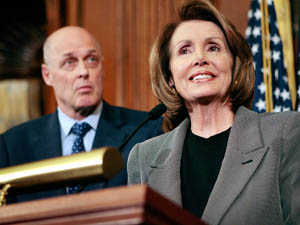Stimulus as if Capitalism Mattered
 Those dispensing the “Bailout to Nowhere” proceeds seemingly answer to no one (here’s one article behaving as if this were unexpected and surprising). Today brought the $9 billion Ford auto credit-line appeal, and the $500 billion Pelosi compound-stimulus proposal. I’m not even a conspiracy theorist but see this lack of accountability as, if not deliberate, surely strategically unprotested by those with the power to make decisions (to illustrate, Pelosi calls her plan an “investment”–it is, from the right hand to the left hand). Note the pattern; no one can be blamed for anything (We tried! We acted “boldly” and kinda like FDR!); but all corners of government and both major political parties can take “credit” when markets finally recover thanks to the toil of individuals.
Those dispensing the “Bailout to Nowhere” proceeds seemingly answer to no one (here’s one article behaving as if this were unexpected and surprising). Today brought the $9 billion Ford auto credit-line appeal, and the $500 billion Pelosi compound-stimulus proposal. I’m not even a conspiracy theorist but see this lack of accountability as, if not deliberate, surely strategically unprotested by those with the power to make decisions (to illustrate, Pelosi calls her plan an “investment”–it is, from the right hand to the left hand). Note the pattern; no one can be blamed for anything (We tried! We acted “boldly” and kinda like FDR!); but all corners of government and both major political parties can take “credit” when markets finally recover thanks to the toil of individuals.
But since accountability is in the air, one good place to implement it is toward the dozens of regulatory agencies throwing their weight around in Washington (to the tune of over 3,000 annual rules, at a cost of over $1 trillion per year. The EPAs and OSHAs populating the Beltway are, like the TARP Captains, staffed by the unelected and wield immense power. Occasionally the feds recognize government deadweight; When Katrina happened, some “bending” of rules allowed less-constrained aid to the needy (for example, makeshift gas stations enjoyed a reprieve of sorts from pollution rules).
That mentality could come in handy now. Another approach needed is for the President-elect to freeze non-essential rules upon taking the oath of office. Then, we need to address agency accountability to the public—here’s how to start:
Publish in the twice-yearly Unified Agenda of Federal Regulations, or Federal Budget the following data by program, agency, and grand total:
–# of major (and minor) rules
–# of major (and minor) rules with cost estimates
–# of major (and minor) rules without cost estimates
–tally of cost estimates that exist
–percentage of major (and minor) rules without cost estimates
–explanation of ratio and reason for lack of cost estimates
–# of rules for which cost calculations statutorily prohibited
–# of regulations required by statute, # that are discretionary
–# reviewed at OMB (and CBO for mandates on lower-level government) and action taken
–Full-time equivalent government employees
–Five-year historical tables for all the above.Publish in the Budget or Economic Report of the President:
–A chapter on the state of regulation: its big and small effects on the economy
–A “Regulatory Flexibility”. summary–detail of aggregate impacts on large and small business
Rather than solely scattering TARP money, at least one or two people in power should be conscious of the (forgotten) proper relationship of the individual to the State. A drastic reduction in federal power over citizens could work wonders. Limiting delegation and re-asserting congressional accountability for major regulations should be reestablished, perhaps by a congressional vote for clearly costly regulations. Other ideas include sunsetting, a “Regulatory reduction commission–and a regulatory budget.